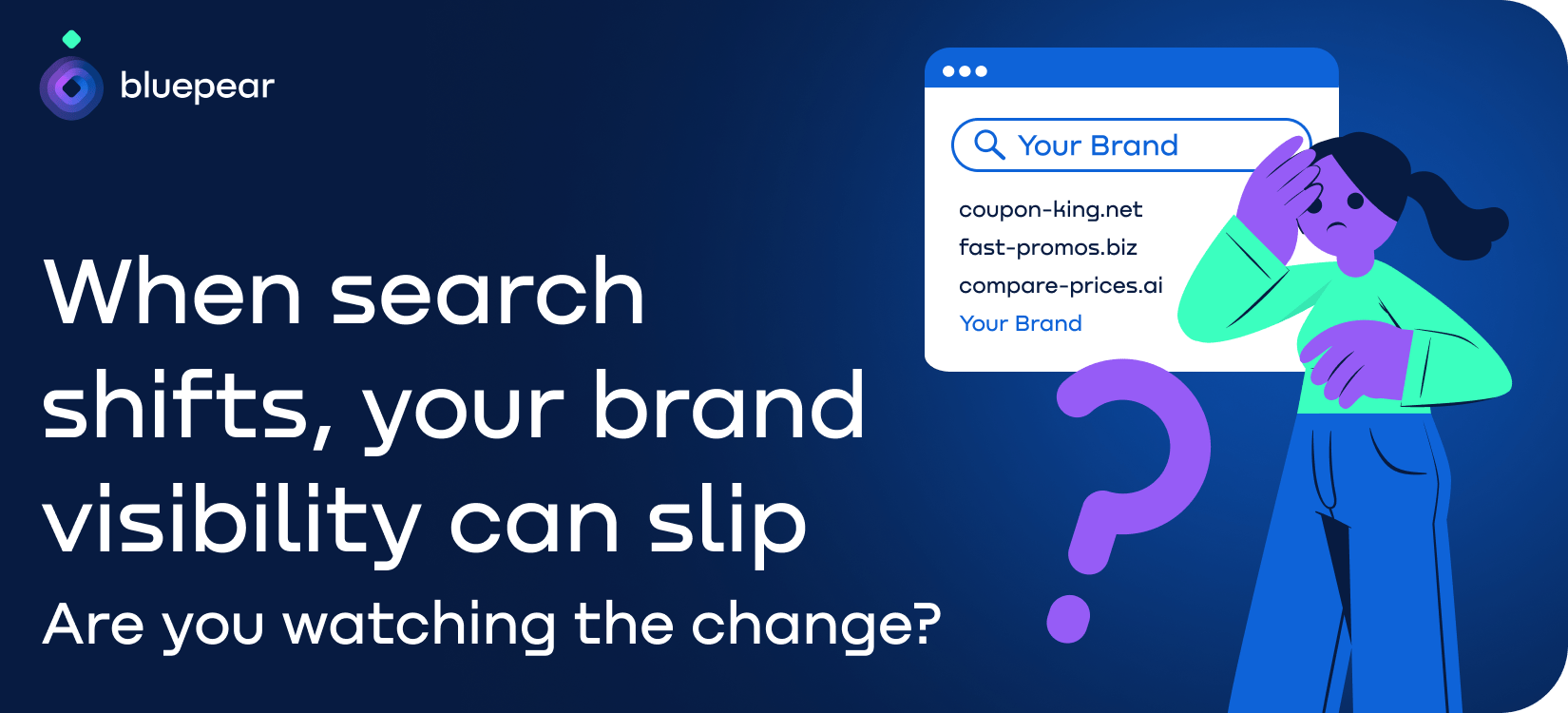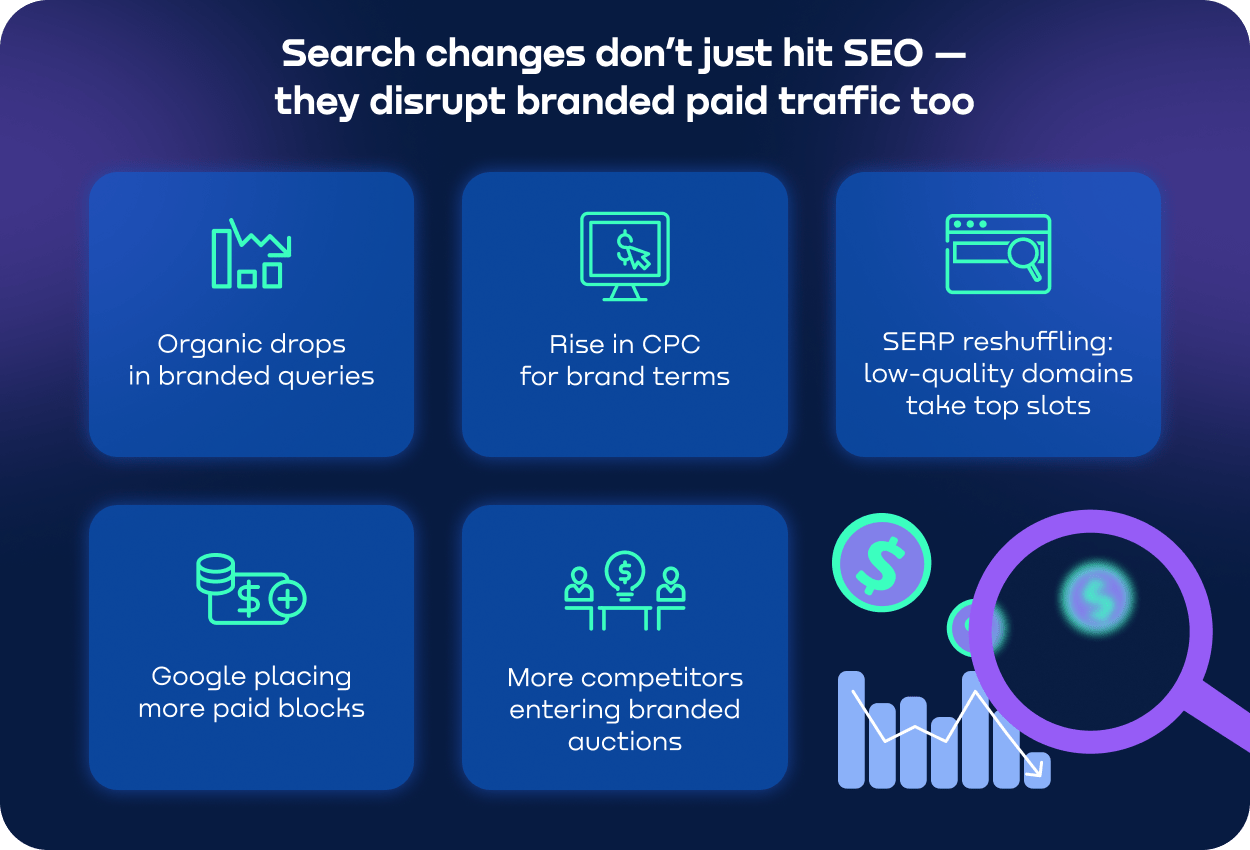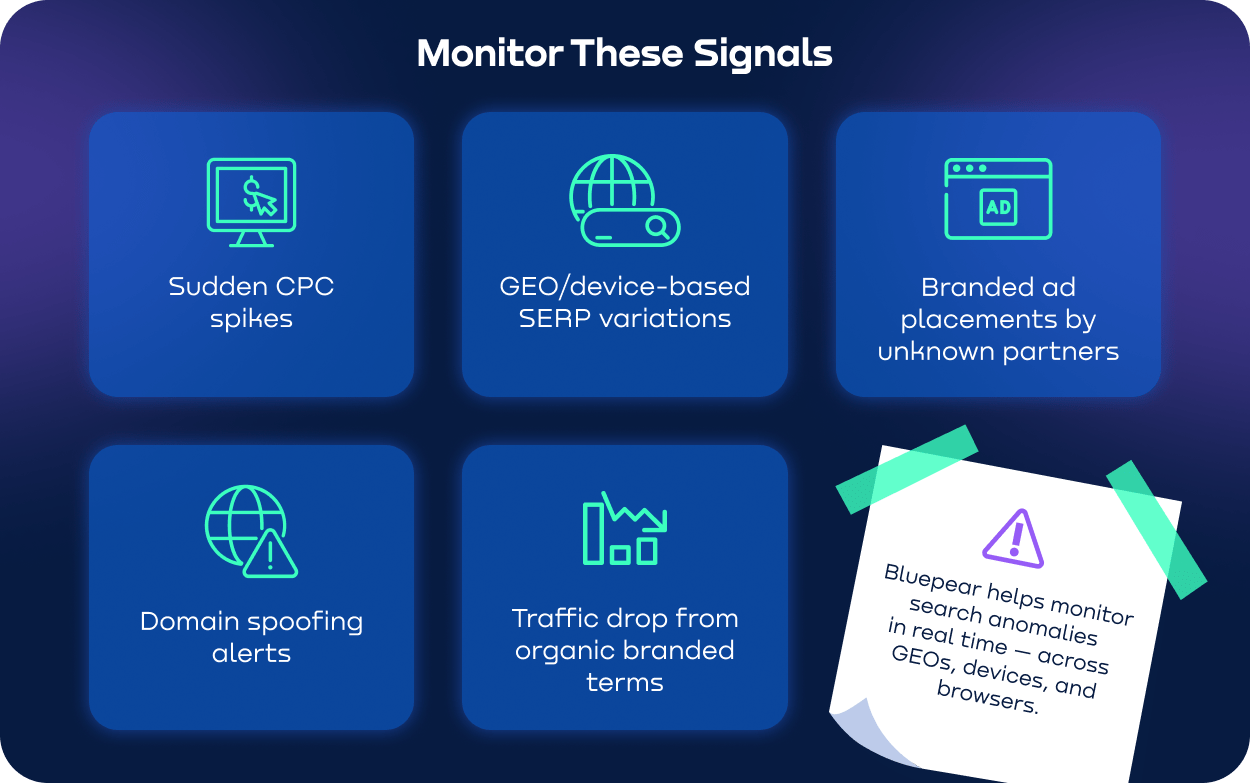
Contents
Google’s latest updates are changing the branded search. And it’s not just about SEO anymore.
The Google algorithm update 2025 has introduced new dynamics to how search results are displayed. There’s now more paid content, AI-generated answers, and increased competition for branded visibility. Most discussions focus on organic rankings, but there’s a less obvious, yet critical area. It’s branded search and paid campaigns.
It’s no longer guaranteed that your brand will appear at the top, even when people search for your company name. With more ads, AI, and new SERP layouts, the competition for visibility is increasing. Brands have to compete even for displaying in their own branded search results.
At the same time, the latest Google ads update is changing paid search. . As organic traffic becomes harder to capture, more brands are shifting focus to PPC. That drives up competition and CPC on branded keywords. It’s no longer just an SEO concern. This Google algorithm change directly impacts your paid search performance and budget.
Understanding how the Google algorithm update works is key for protecting your brand online. Knowing how exactly Google ads update impacts both organic and paid channels.
In this article, we’ll look at how the new algorithm impacts branded search, why even PPC campaigns are affected, and how tools like the Google algorithm sensor can help track those changes.
Google Algorithm Update 2025
Let’s start with an overview of the exact Google algorithm changes:
Overview of Google Algorithm Update
The Google algorithm change 2025 has introduced significant changes that affect how brands appear in search results. This update focuses heavily on AI-generated content, dynamic SERP layouts, and improved user intent detection. For brands, the biggest shift is the reduced predictability of organic rankings.
Here’s what’s new:
• AI-powered answer boxes. Google now shows more AI-generated summaries at the top of the page. These often push down organic results, even for branded searches.
• Dynamic search features. SERPs adapt more in real-time based on user behavior, meaning your brand’s visibility can fluctuate throughout the day.
• Authority signals update. Google prioritizes content quality and trust signals more than ever, which affects brand websites that previously ranked on name recognition alone.
The result? Even established brands are seeing their organic traffic drop. Relying only on SEO is no longer enough — staying visible now requires combining organic, paid, and monitoring strategies.
Google Ads Update: New Features Impacting Brands
The Google Ads Update 2025 changes how paid campaigns function, with direct consequences for branded search. Google is using more automation, AI-driven ad placement, and real-time bidding adjustments.
Here’s what’s affecting brands:
• Increased AI automation. Campaigns rely more on AI to decide when and where your ads appear, which reduces manual control but speeds up optimization.
• Smarter competitor targeting. Google makes it easier for competitors to run ads on your branded keywords. As organic space shrinks, more brands fight for paid positions.
• CPC growth. Cost-per-click on branded terms is rising due to increased demand and automated bidding strategies. Even for your own brand name, you now pay more.
• New ad formats. AI-generated ads and richer ad previews appear more often, sometimes overshadowing traditional branded results.
Brands need to monitor performance closely. Paid search is no longer a guaranteed safe space — your competitors can appear above you even on your own brand terms.
Google Algorithm Sensor & Real-time Monitoring
With so many Google updates happening, real-time monitoring has become essential. Google’s systems now adjust search results constantly, based on AI, machine learning, and live user behavior.
Here’s why brands need to track this:
• Algorithm sensors detect changes. Tools like Google algorithm sensor show when rankings change, often before it’s obvious in your traffic data.
• Paid and organic interconnected. Shifts in organic search directly influence PPC performance. If your brand drops organically, your paid campaigns often become more expensive.
• Protecting brand search visibility. Competitors can capitalize on SERP changes quickly. Without real-time monitoring, you risk losing both traffic and ad efficiency.
• Instant alerts for SERP changes. Modern tools provide alerts for SERP layout shifts, new AI blocks, or competitor ads appearing on your brand terms.
Monitoring isn’t just for SEO teams anymore. Paid search, branding, and marketing teams need to implement tools like Google algorithm sensor or brand bidding monitor.

Google Ads Update: Why CPC Increases
With the latest Google algorithm update 2025, organic rankings have become less stable. Your brand may not always appear at the top — even for searches with your company name. That’s why many businesses increase their focus on paid search. But here’s the catch: your competitors are doing the same, often targeting your branded keywords.
What competitors do this for?
• High-intent traffic. People searching your brand are ready to buy or engage. Competitors know this is qualified traffic with strong intent.
• Quick visibility. Running ads on your branded keywords gives them instant access to your audience — without building awareness from scratch.
• Aggressive market strategy. This approach decreases your brand’s visibility which helps your competitors to get a larger market share.
Bidding on competitors' brands is legal under Google’s rules, as long as trademarks aren’t misused in ad copy. That’s why brands have to either file a trademark infringement complaint or raise CPC to buy their own branded search back.
How does this look in real life?
-
A user searches for your brand, for example, “YourBrand Software”.
-
Your competitor's paid ad appears above your website, offering a similar product or better deal.
-
If your paid search isn't monitored, competitors stay on top, your CPC rises, and you lose clicks.
-
With automated monitoring, you get alerts when competitors enter your branded search space — so you can react quickly.
That’s why automated monitoring is critical. Modern tools track when competitors start bidding on your branded keywords. The software also catches brand bidding in affiliate marketing. Automated tools detect unauthorized brand bidding, and alert your team instantly. You can respond fast — adjusting bids, optimizing ad copy, or filing a complaint.
Without real-time monitoring, your costs rise silently, and you lose control over your brand in search.
Hidden Threats Beyond CTR & ROAS
Most brands focus on CTR (click-through rate) and ROAS (return on ad spend) to measure the success of their paid search campaigns. But there are hidden risks that can hurt your brand — even if your numbers look good on paper.
Here are the key threats to watch:
Brand cannibalization. This happens when your paid ads compete with your own organic results. After the Google algorithm update 2025, organic visibility is more unstable. Many brands spend more on PPC to stay visible — but sometimes they end up overpaying for their own organic traffic. It inflates costs without bringing new users.
Ad fraud. Ad fraud is when fake clicks or impressions drain your budget. Bots or bad actors generate non-human traffic, making it look like your ads perform. In reality, you waste money and get no real customers.
Domain spoofing. With domain spoofing, scammers imitate your website or brand in ads. Users see what looks like your site, but it redirects them elsewhere. It damages trust, confuses customers, and steals your traffic.
Ad fraud detection tools help detect these risks early — so you protect your brand and budget.
How to Recover from Google Algorithm Update
The latest Google algorithm update has made it harder for brands to stay visible, even on their own keywords. But with the right tools and strategy, you can recover lost ground and protect your brand search. Here’s what works:
• UTM analysis. Adding UTM tags to your paid campaigns helps track exactly where your traffic and conversions come from. It shows the true performance of branded search and helps detect if paid traffic is cannibalizing organic clicks.
• Competitor analysis. Regularly check how competitors position themselves on your branded keywords. Track their ad copy, offers, and placements. Understanding their strategy helps you defend your brand more effectively.
• Automated brand monitoring. Use real-time monitoring tools to track how your brand appears in both paid and organic search. These tools send alerts when your positions change, competitors run ads on your brand, or CPC spikes. This lets you react fast and stay in control.
Here’s how automated monitoring looks with Bluepear:
• You simply enter the branded keywords you want to monitor.
• Bluepear automatically scans Google search results using different devices, browsers, and locations — just like real users.
• The system detects competitor ads, affiliate promotions, coupon websites, and cloaked landing pages.
• You receive instant alerts with clear evidence: screenshots, affiliate links, redirects, and ad copies.
• As a result, you quickly block fraud, keep your branded traffic clean, and maintain higher visibility and conversion rates in search.
That way, you stay informed and can respond fast — blocking unauthorized ads, protecting your brand space, and keeping your paid search performance stable despite the Google algorithm change.

Competitor Analysis After Google Ads Update
Now let’s see how competitor analysis should be performed to recover from Google ads update. A SaaS company, let's call them Softwise, noticed a steady rise in CPC on their branded keywords after the latest Google algorithm update. Their organic traffic also started dropping, even on clear brand-related searches. Using competitor analysis tools, Softwise discovered that two direct competitors were actively bidding on their brand name. Their ads promised lower pricing and free trials, which attracted potential customers away from Softwise's own website.
The team tracked:
✔️ Competitor ad copy variations.
✔️ Promotions used in competitor ads.
✔️ When and where these ads appeared.
With this data, Softwise adjusted their own branded ad strategy. They refreshed their ad copy, highlighted unique benefits, and increased bids during peak hours when competitor ads were most active. As a result, they reduced traffic loss, stabilized CPC, and regained control over their branded search space — all by monitoring competitors consistently.
Google Ads Algorithm Update 2025
The Google ads update 2025 has changed how search works — brands are losing positions, and even paid search is under pressure. Staying visible now means constant monitoring and smart tools. With UTM tracking, competitor analysis, and real-time alerts, you can protect your brand and stay visible. Automated brand monitoring, combined with tools like the Google algorithm sensor, helps you track Google algorithm changes in real time and keep your search results under control.
FAQ
1. How to recover from the Google algorithm update?
Use UTM tracking, competitor analysis, and automated brand monitoring to stay visible and protect your paid and organic search.
2. What are the key Google Ads updates in 2025?
More AI-driven ads, dynamic placements, and higher competition on branded keywords — all pushing CPC up.
3. Can competitors bid on my branded keywords?
Yes, it’s allowed. That’s why real-time monitoring is key to spotting competitor ads and defending your brand.
4. How can Bluepear help recover from Google algorithm updates?
Bluepear spots unauthorized ads, coupon sites, and cloaked pages that push your brand down in search results.

